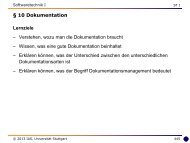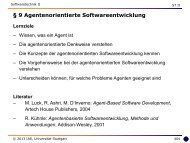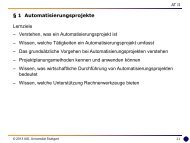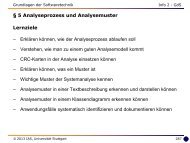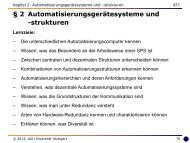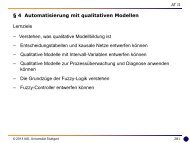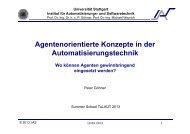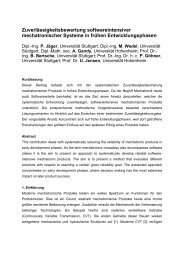Grundlagen FlexRay - Institut für Automatisierungs- und ...
Grundlagen FlexRay - Institut für Automatisierungs- und ...
Grundlagen FlexRay - Institut für Automatisierungs- und ...
You also want an ePaper? Increase the reach of your titles
YUMPU automatically turns print PDFs into web optimized ePapers that Google loves.
<strong>Gr<strong>und</strong>lagen</strong> <strong>FlexRay</strong> BasicsV 1.1 14<br />
Figure 2.3 States of the Communication Controllers [FRPS05]<br />
The Communication Controller can be in the following states (see also Figure 2.3):<br />
• default config – Startup state of the Communication Controller. In this state, no<br />
communication is possible, since no information concerning the connected <strong>FlexRay</strong><br />
network are available.<br />
• config – The microcontroller submits specific data from the FIBEX or AUTOSAR<br />
file, which is necessary for the operation of the Communication Controller.<br />
• ready – The Communication Controller has been successfully set up and is ready for<br />
starting the communication process. It can either join an existing system, or wakeup<br />
an idle network.<br />
• wakeup – If the <strong>FlexRay</strong> node is connected to an idle network, the microcontroller<br />
can instruct the Communication Controller to wake up the network. The controller<br />
switches to the wakeup state, and starts transmitting the Wakeup Pattern, see section<br />
2.6.<br />
• startup – In this state, the node tries to synchronize with the bus. Depending on the<br />
role of the node, there are two different procedures. If the node is a Coldstart Node, it<br />
actively participates in the synchronization process of the network. Otherwise, it uses<br />
the existing bus communication to synchronize itself.<br />
Bäurle 12.10.2012




